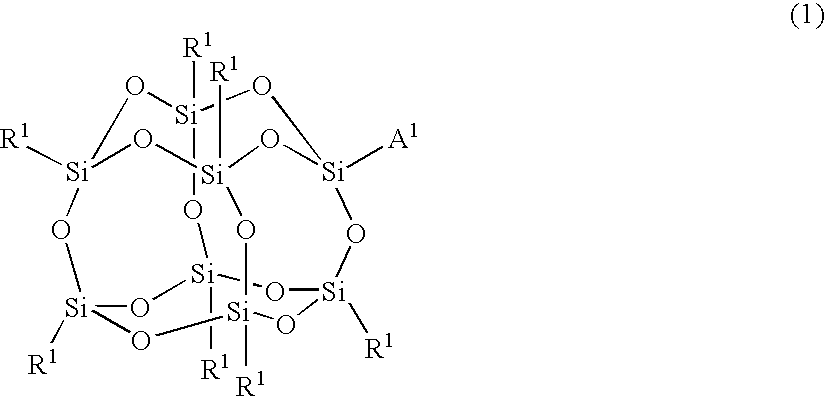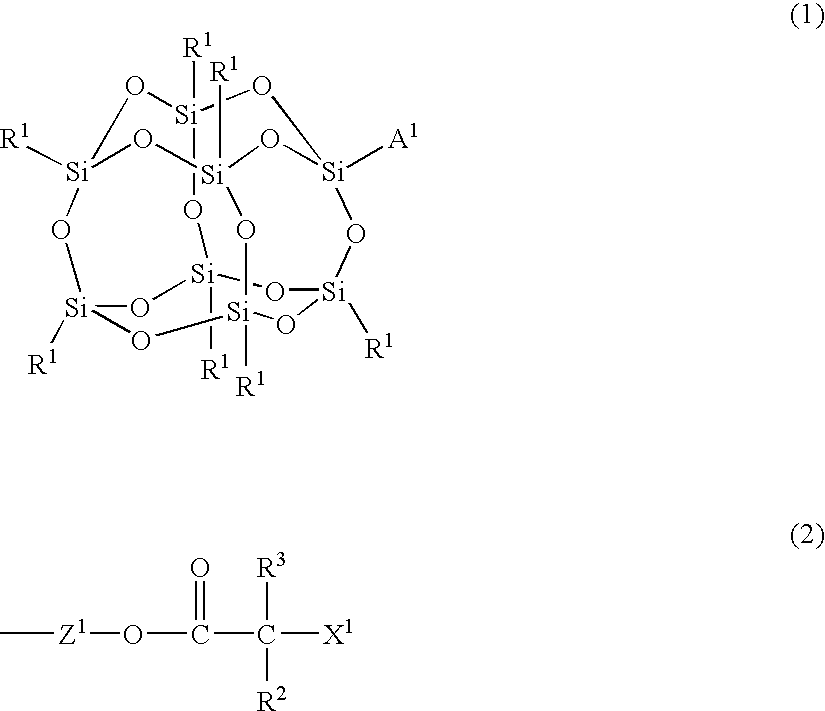Silicon compounds
- Summary
- Abstract
- Description
- Claims
- Application Information
AI Technical Summary
Benefits of technology
Problems solved by technology
Method used
Image
Examples
example 1
Synthesis of polyphenylsilsesquioxane (compound A)
[0100] a Four Neck Separable Flask Having a Content Volume of 2 liter equipped with stirrer, a reflux condenser, a thermometer and a dropping funnel was charged with ice and water (640.7 g) and toluene (200 g), and the inside of the flask was cooled to 0° C. while stirring. Next, a mixed solution of phenyltrichlorosilane (211.5 g) and toluene (130 g) dried on molecular sieves for a whole day and nigh was dropwise added thereto in one hour so that a temperature of the inside of the flask did not exceed 2° C. Then, after stirring at a room temperature for 30 minutes, the solution was washed with refined water, and toluene was distilled off under reduced pressure to obtain a solid compound A (120.7 g). The compound A had a weight average molecular weight of about 3100.
example 2
Synthesis of sodium-bonded phenylsilsesquioxane compound (compound B)
[0101] A four neck flask of 500 ml equipped with a reflux condenser and a thermometer was charged with the compound A (12.9 g) obtained above, tetrahydrofuran (250 ml) dried on molecular sieves for a whole day and night and sodium hydroxide (4.0 g), and the flask was heated at 67° C. while stirring by means of a magnetic stirrer to maintain a reflux state. After about 4 hours, the solution began to get cloudy by deposition of fine powder, and refluxing was continued for one hour as it was to finish the reaction. A solid matter deposited was washed with tetrahydrofuran and separated from tetrahydrofuran by filtering, and then it was dried under vacuum to obtain a compound B (10.1 g).
example 3
Synthesis of sodium-bonded phenylsilsesquioxane compound (compound B) using phenyltrimethoxysilane as a raw material
[0102] A four neck flask having a content volume of one liter equipped with a reflux condenser, a thermometer and a dropping funnel was charged with phenyltrimethoxyosilane (99 g), sodium hydroxide (10 g) and 2-propanol (500 ml), and a rotator was put thereinto. Deionized water 11 g was dropwise added thereto from the dropping funnel in about 2 minutes while stirring at a room temperature by means of a magnetic stirrer, and then the flask was heated on an oil bath up to a temperature at which 2-propanol was refluxed. After refluxing was started, stirring was continued for 1.5 hour to complete the reaction. Then, the flask was pulled up from the oil bath and left standing still a night at a room temperature to completely deposit a solid matter produced. The solid matter deposited was filtrated by means of a pressure filter equipped with a membrane filter having a pore ...
PUM
 Login to View More
Login to View More Abstract
Description
Claims
Application Information
 Login to View More
Login to View More - R&D
- Intellectual Property
- Life Sciences
- Materials
- Tech Scout
- Unparalleled Data Quality
- Higher Quality Content
- 60% Fewer Hallucinations
Browse by: Latest US Patents, China's latest patents, Technical Efficacy Thesaurus, Application Domain, Technology Topic, Popular Technical Reports.
© 2025 PatSnap. All rights reserved.Legal|Privacy policy|Modern Slavery Act Transparency Statement|Sitemap|About US| Contact US: help@patsnap.com



